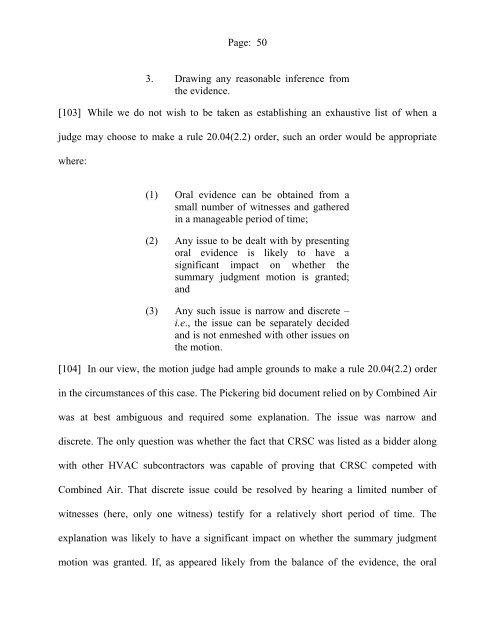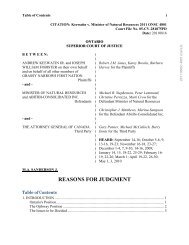COURT OF APPEAL FOR ONTARIO
COURT OF APPEAL FOR ONTARIO
COURT OF APPEAL FOR ONTARIO
Create successful ePaper yourself
Turn your PDF publications into a flip-book with our unique Google optimized e-Paper software.
Page: 50<br />
3. Drawing any reasonable inference from<br />
the evidence.<br />
[103] While we do not wish to be taken as establishing an exhaustive list of when a<br />
judge may choose to make a rule 20.04(2.2) order, such an order would be appropriate<br />
where:<br />
(1) Oral evidence can be obtained from a<br />
small number of witnesses and gathered<br />
in a manageable period of time;<br />
(2) Any issue to be dealt with by presenting<br />
oral evidence is likely to have a<br />
significant impact on whether the<br />
summary judgment motion is granted;<br />
and<br />
(3) Any such issue is narrow and discrete –<br />
i.e., the issue can be separately decided<br />
and is not enmeshed with other issues on<br />
the motion.<br />
[104] In our view, the motion judge had ample grounds to make a rule 20.04(2.2) order<br />
in the circumstances of this case. The Pickering bid document relied on by Combined Air<br />
was at best ambiguous and required some explanation. The issue was narrow and<br />
discrete. The only question was whether the fact that CRSC was listed as a bidder along<br />
with other HVAC subcontractors was capable of proving that CRSC competed with<br />
Combined Air. That discrete issue could be resolved by hearing a limited number of<br />
witnesses (here, only one witness) testify for a relatively short period of time. The<br />
explanation was likely to have a significant impact on whether the summary judgment<br />
motion was granted. If, as appeared likely from the balance of the evidence, the oral
















